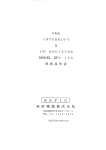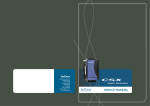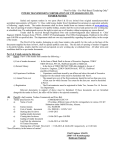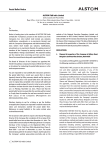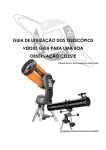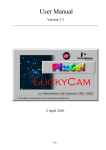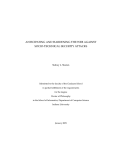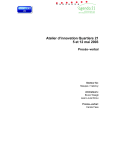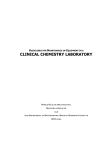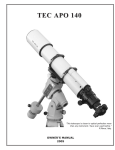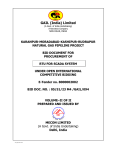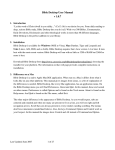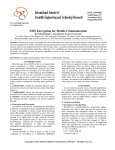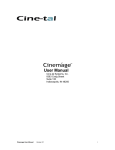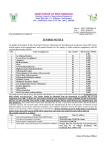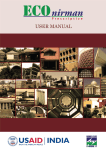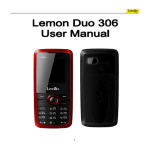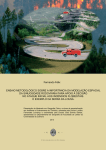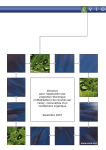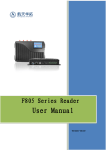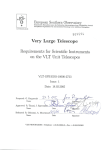Download 104-cm Sampurnanand Telescope
Transcript
User’s Manual 104-cm Sampurnanand Telescope Aryabhatta Research Institute of Observational-SciencES Manora Peak, Naini Tal - 263 129 Uttaranchal, India Prepared by Brijesh Kumar and Kuntal Misra April 2006 Table of Contents List of Figures ii List of Tables iii 1 About the manual 1 2 Telescope description 2 3 Back-end Instruments 3.1 CCD Cameras . . . . . . . . . . . . . . . . . . . . 3.1.1 CCD-01 . . . . . . . . . . . . . . . . . . . . 3.1.2 CCD-02: 1k Tek CCD . . . . . . . . . . . . 3.1.3 CCD-03: 2k Wright CCD . . . . . . . . . . 3.1.4 CCD-04: 1k Pixel CCD . . . . . . . . . . . 3.1.5 Capabilities of the CCD cameras . . . . . . 3.2 ARIES Imaging Polarimeter (AIMPOL) . . . . . . 3.3 ARIES Three Channel Fast Phototmeter (ATCFP) 3.4 ARIES Infrared Photometer (AIP) . . . . . . . . . 3.5 ARIES CCD spectrograph (ACS) . . . . . . . . . . . . . . . . . . . . . . . . . . . . . . . . . . . . . . . . . . . . . . . . . . . . . . . . . . . . . . . . . . . . . . . . . . . . . . . . . . . . . . . . . . . . . . . . . . . . . . . . . . . . . . . . . . . . . . . . . . . . . . . . . . . . . . . . . . . . . . . . . . . . . . . . . . . . . . . . . . . . . . . . . . . . . . . . . . . . . . . . . . . . . . . . . . . . . . . . 5 5 5 5 5 6 6 7 7 8 8 4 Observing with the telescope 4.1 Attending Lights and Doors . . . . . . . . . . . 4.2 Switching on the Sidereal clock . . . . . . . . . 4.3 Switching on the Telescope Console and Dome 4.4 Mounting the appropriate instrument . . . . . 4.5 LN2 filling in CCD dewar . . . . . . . . . . . . 4.6 Setting the sidereal clock . . . . . . . . . . . . 4.7 Correcting the sidereal clock . . . . . . . . . . . 4.8 Setting the ST4 Auto-guider . . . . . . . . . . . . . . . . . . . . . . . . . . . . . . . . . . . . . . . . . . . . . . . . . . . . . . . . . . . . . . . . . . . . . . . . . . . . . . . . . . . . . . . . . . . . . . . . . . . . . . . . . . . . . . . . . . . . . . . . . . . . . . . . . . . . . . . . . . . . . . . . . . . . . . . . . . . . . . . . . . . 10 10 11 11 11 11 12 12 13 . . . . . . . . . . . . . . . . 5 Instrument operation, data acquisition and archiving procedure 14 6 Telescope Startup and Shutdown Checklist 15 7 Emergency calls and assistance 17 Bibliography 18 i List of Figures 2.1 Rough Ray Tracings for the whole telescope tube and the Cassegrain end of the telescope respectively from left to right. This poor picture drawn originally with HB Pencil looks alright in print. Instruments weighing 150 kg can be mounted with the instrument ring drawn in 2nd picture. 3.1 . . . . . . . . . . . . . . . . . 3 Photographs of the ccd cameras complete with LN2 dewar refer CCD-02/1k Tek CCD, CCD-03/2k Wright CCD, CCD-04/1k Pixel CCD respectively from left to right. Note that the camera controller for 2k CCD is mounted with Dewar itself while it is provided separately for other cameras. The Mechanical Shutter unit for both CCD-02 and CCD-04 is mounted with the camera. The mechanical shutter being sophisticated for the 2k CCD is provided separately. 3.2 . . . . . . . . . . . . . . . . . . . . . . . . . . . . . . . . 6 Photographs of the ccd cameras complete with the filter disc Assembly for CCD-02/1k Tek CCD and CCD03/2k Wright CCD respectively from left to right. Filter disc for 1k Tek has auto rotation while the the Wright 2k ccd filter disc is still rotated manually. Camera controller for 1k Tek CCD is mounted separately. There are mounted upside down at the Cassegrain end of the telescope. 3.3 . . . . . . . . . . . . . . . . Rough Mechanical drawings for CCD-02/1k Tek CCD and CCD-03/2k Wright CCD respectively from left to right. This poor picture drawn originally with HB Pencil looks alright in print. 3.4 3.5 6 . . . . . . . . . . . . Photographs of the Fast photometer and Imaging polarimeter as mounted at the Cassegrain end of the telescope. 7 8 Photographs of the Infrared photometer and the Low resolution CCD spectrograph are shown respectively from left to right. The white aluminium plate in ccd spectrograph is used for mounting 1k Tek CCD. ii . . . 9 List of Tables 2.1 2.2 Fundamental Parameters for the 104-cm Sampurnanand Telescope . . . . . . . . . . . . Design parameters and aplanatic constants for 104-cm Sampurnanand Optical Telescope iii 2 4 Chapter 1 About the manual This document contains general description and operations of the 104-cm Sampurnanand Optical Telescope and its back-end instrumentation. The detailed technical description about the telescope and the available instruments can be found in the cited documentation. The materials in this manual and the subsequent updates are available at http://aries.ernet.in. 1 Chapter 2 Telescope description The 104-cm Sampurnanand Optical Telescope, located at Manora Peak, Nainital, is the main optical observing facility of Aryabhatta Research Institute of Observational Sciences. This facility is popularly known as 40-inch telescope amongst ARIES staff. It was installed in 1972 by Carl Zeiss, Germany. The telescope is an RC reflector with a Cassegrain and a Coude focus with equatorial 2-pier english mounting. Three finder telescopes are also provided with clear aperture of around 10-inch (264 mm, f/14, reflector), 8-inch (200 mm, f/15, refractor) and 4-inch (110 mm, f/7, refrator type). The 8 and 4-inch finder telescopes are equipped with eyepieces which covers around 20 and 90 arcmin field of view respectively. The 8-inch refractor is also used for guiding the main (104-cm) telescope. A field of around 45 arcmin with corrector is available at the cassegrain end of the telescope. The tracking accuracy is around 7 arcsec/hr (0.1 arcsec/min) without guider and is around 0.7 arcsec/hr with guider. The off-axis guiding of the telescope is done through 8-inch finder telescope using ST4. The fundamental telescope parameters are given in Table 2.1 while the derived parameters are listed in Table 2.2. Over 266 publications have resulted so far based on the data from the 104-cm telescope. Table 2.1: Fundamental Parameters for the 104-cm Sampurnanand Telescope Parameter Primary Diameter Primary focal length Effective focal length Separation Value 104 416 (f/4) 1330 (f/13) 292 Unit cm cm cm cm Detailed description of the telescope optics, mounting and control, etc., is provided in the paper by Sinvhal et al. 1972, Proc. Symp. ”Optical Astronomy with moderate size telescopes”, ARIES library reprint No. 64. With time, the reflectivity of the primary mirror degraded and hence the regular aluminisation of the primary mirror is being done in alternate years since 1997. Post aluminisation image quality status of the telescope is described in a technical report prepared by K G Gupta and Brijesh Kumar and it can be obtained from the authors. 2 CHAPTER 2. TELESCOPE DESCRIPTION Figure 2.1: 3 Rough Ray Tracings for the whole telescope tube and the Cassegrain end of the telescope respectively from left to right. This poor picture drawn originally with HB Pencil looks alright in print. Instruments weighing 150 kg can be mounted with the instrument ring drawn in 2nd picture. CHAPTER 2. TELESCOPE DESCRIPTION 4 Table 2.2: Design parameters and aplanatic constants for 104-cm Sampurnanand Optical Telescope Parameter y1 0 f1 d1 0 f m2 RA L T b P 0 f2 y2 c1 c2 D2 Dh2 ε S S N1 N r1 r2 Expression 0 − 1+ bs1 bs2 − m2 −1 2 m2 +1 − 2f d1 (m2 +1)3 H ζ s1 s2 2L d1 m3 2 (m2 +1)2 4 h Value 520.0000000 −2920.0000000 13300.0000000 −4160.0000000 −3.1971154 0.2980769 3964.4230957 3.3548386 1044.4230957 5204.4228516 −1804.3763428 155.0000000 −0.0001202 −0.0002771 324.0000000 420.0000000 0.4038461 15.5086470 0.0644802 −4.0000000 12.7884617 −8320.0000000 −3608.7526855 Unit mm mm mm mm number number mm number mm mm mm mm rad/mm rad/mm mm mm number arcsec/mm mm/arcsec number number mm mm Conic constant for the primary −1.0830907 Conic constant for the secondary −4.5080814 number 0.0000000 rad mm Dimensionless quantity 1.3576792 number Dimensionless quantity −1.0365396 number Conic shape for the primary Conic shape for the secondary Angle of the incoming principle ray with the axis of the primary Distance from the surface to the entrance pupil of the primary mirror Length of secondary’s conical baffle Hood diameter of the secondary’s conical baffle Full diameter of the secondary mirror Secondary Thickness Secondary aspect Ratio Length of primary’s cylindrical baffle Diameter of primary’s cylindrical baffle Diameter of primary’s central hole Full diameter of the primary mirror Primary Thickness Primary aspect Ratio −0.0830907 −3.5080814 number number number 0 H ξ 0 f /f1 0 1 − (d1 /f1 ) 0 f RA 1/RA L + d1 0 b − f1 L/(1 + m2 ) y1 RA 0 1/2f1 0 1/2f2 D2 Dh2 Dh2 /2y1 0 206265/f 1/S 0 f1 /2y1 0 f /2y1 0 2f1 0 2f 2 Description Semi-aperture of the primary Focal length of the primary Separation between primary and secondary Effective focal length of the system Magnification of the secondary Axial obstruction ratio Constructional length True telephoto effect Back focal distance Distance between primary and secondary images Focal length of the secondary Axial beam semi-diameter of the secondary Vertex curvature for the primary Vertex curvature for the secondary Full diameter of the secondary Hood diameter of the secondary’s conical baffle Central obstruction factor Plate scale Inverse plate scale Primary f/no Final f/no Radius of curvature of the primary Radius of curvature of the secondary m3 2 (1 + bs1 ) 2 m2 −1 2 + bs2 m2 +1 i upr1 1 + bs1 1 + bs2 upr1 spr1 spr1 The Lagrange invariant variable 0.0000000 325.0000000 420.0000000 324.0000000 54.0000000 6.0000000 244.0000000 240.0000000 1060.0000000 173.0000000 6.0115606 mm mm mm mm number mm mm mm mm mm number Chapter 3 Back-end Instruments Five instruments are available at present for use with the Cassegrain end of the telescope. 3.1 CCD Cameras CCD Imaging cameras/photometers are being used at ARIES since 1989 and below is an overview of the various cameras which were/are in use so far. 3.1.1 CCD-01 This is a Tektronics 384 x 576 ccd detector with 24 micron pixel size covering an area of 2 x 3 arcmin. This camera was bought in 1989 and has become outdated now. The characterisation of this photometric system and few scientific results can be found in the papers by Mohan V. et al. (1991) and Bhatt B. C. et al. (1993). More details about this detector, camera controller, LN2 dewar and data acquisition software, can be obtained from the complete documentation kept in 40-inch telescope house. 3.1.2 CCD-02: 1k Tek CCD This is a Tektronics 1024 x 1024 grade 1 ccd with 24 micron pixel size. This camera was acquired in 1992 and is being used currently at ARIES. The detector covers an area of around 6 x 6 arcmin sky, works in non-MPP mode with dark current equal 0.56 e− /sec/pix at -110 deg C, 4X gain 2.96 e− /ADU. Well capacity is 390 ke. It can work at three gain (1X, 2X, 4X) settings viz gain = 11.98 e− /ADU, read = 7.0, 5.0 and 4.1 electrons. It is a slow 40 kHz system with 15-bit A/D converter. Mean bias level for this system is 500 ADUs at 1X gain setting. More details about QE etc. can be found in the CCD camera manual available at 40inch telescope. Refer paper by Durgapal A. K. et al. (1997) for scientific results using this ccd. 3.1.3 CCD-03: 2k Wright CCD Wrights (2k) 2048 x 2048 ccd with 24 micron pixel size. This camera was acquired in 1999 and is still in use. This works in MPP mode with dark level less than 1e-5 e− /pix/sec. Covers an area of 13 x 13 arcmin and its operating temperature is 160 K. The CCD reads out its pixels with high (132 kHz, 7.6 micro sec) or low (27 kHz, 36.7 micro sec) speed and the corresponding gain(e− /ADU)/readnoise(e− ) settings are 10/13.7 and 10/5.3. Saturation level is 280 ke and it uses 15-bit A/D converter. This CCD is more sensitive in the red band. For QE and bad pixels please refer to the camera manual. Scientific results using this detector are contained in the theses 5 CHAPTER 3. BACK-END INSTRUMENTS 6 by Yadav R. K. S. (2002), Nilakshi (2002), Stalin C. S. (2002), Joshi Y. C. (2003), Pandey S. B. (2005), Upadhyay K. K. (2005), Pandey J. C. (2005). 3.1.4 CCD-04: 1k Pixel CCD Pixcellent (1k) 1242 x 1158 CCD with 22.5 micron pixel size. This camera was acquired in February 2005 and is being made ready for observations. Its main characteristics are: back illuminated with QE > 90 % at 500 nm, 16 bit digitisation, grade 0 device, readout rate adjustable from 25 to 167 kHz, readnoise around 4 e− rms, gain ranges from 1.33 to 10 e− /adu, full well capacity 200 ke. Figure 3.1: Photographs of the ccd cameras complete with LN2 dewar refer CCD-02/1k Tek CCD, CCD-03/2k Wright CCD, CCD-04/1k Pixel CCD respectively from left to right. Note that the camera controller for 2k CCD is mounted with Dewar itself while it is provided separately for other cameras. The Mechanical Shutter unit for both CCD-02 and CCD-04 is mounted with the camera. The mechanical shutter being sophisticated for the 2k CCD is provided separately. Figure 3.2: Photographs of the ccd cameras complete with the filter disc Assembly for CCD-02/1k Tek CCD and CCD-03/2k Wright CCD respectively from left to right. Filter disc for 1k Tek has auto rotation while the the Wright 2k ccd filter disc is still rotated manually. Camera controller for 1k Tek CCD is mounted separately. There are mounted upside down at the Cassegrain end of the telescope. 3.1.5 Capabilities of the CCD cameras Modern CCD camera with 104-cm telescope and a good site like Nainital is capable of carrying out deep UBVRI 20 mag photometry with magnitude and color accuracies of about 0.01 magnitude. CHAPTER 3. BACK-END INSTRUMENTS 7 Figure 3.3: Rough Mechanical drawings for CCD-02/1k Tek CCD and CCD-03/2k Wright CCD respectively from left to right. This poor picture drawn originally with HB Pencil looks alright in print. The filter set available at ARIES is Johnsons UBV and Cousins RI. Differential photometry using CCD can detect variations of 1, 5, 10 and 20 mmag in a star with apparent magnitude of 10, 15, 18 and 20 respectively. Please note that these are very rough numbers and consult proper person and literature for actual figures. 3.2 ARIES Imaging Polarimeter (AIMPOL) The AIMPOL has recently been developed and is in use since 2004 (see Figure 3.4). This instrument measures linear polarisation in BVR bands and has a field of view of around 2 arcmin. Using 104cm telescope,it can measure polarisation of a 13 magnitude star in 2 minute exposure time with 0.18 percent accuracy. This Polarimeter uses Tektronics 1k ccd (described above) as detector. Performance of this instrument was carried out recently and is published by Rautela et al. (2002). 3.3 ARIES Three Channel Fast Phototmeter (ATCFP) Fast photometer at ARIES (see Figure 3.4) is functional since last five years. This is a PMT based device and is capable of detecting light variation of 0.2 mmag in good sky conditions. This instrument is well suited for short period ( minutes) and small amplitude ( mmag) variability work for bright stars upto 13 to 15 mag only. A S/N ratio of 3 can be achieved in 10 sec integration time of a 10 mag star. Short exposures from ms to tens of seconds with almost zero dead time (23 ns) between two consecutive exposures are possible. For details on the instrument and science refer to the theses by Joshi S. (2005), Girish V. (2005), Ashoka B. N. (2005) and the manual maintained at 40-inch telescope house. A detailed manual was prepared recently by David Mary CHAPTER 3. BACK-END INSTRUMENTS 8 and Ramanpreet Kaur on the operation of the instrument, data acquisition software (q9) and a bit on data analysis procedures too. 3.4 ARIES Infrared Photometer (AIP) The infrared photometer employs InSb based photovoltaic detector and a preamplifier electronics (see Figure 3.5). The instrument is also being developed at ARIES. Latest testing indicates that the instrument is capable of observing 6 mag star in J band and 4 mag star in K band. The result is still unpublished. 3.5 ARIES CCD spectrograph (ACS) HR-320 spectrograph is used along with the Tektronics 1k CCD detector to take low resolution spectra of bright stars up to 12 mag. It uses circular aperture and is best suited for estimating continuum and broad (EW 10 angstrom or higher) emission features in stars or astronomical objects. A few papers using this instrument are Sanwal et al (2004) Joshi S. et al. (2003), Pandey J. C. et al. (2005). For further details refer Figure 3.5 and the manuals kept at 40-inch telescope house. Figure 3.4: Photographs of the Fast photometer and Imaging polarimeter as mounted at the Cassegrain end of the telescope. CHAPTER 3. BACK-END INSTRUMENTS Figure 3.5: 9 Photographs of the Infrared photometer and the Low resolution CCD spectrograph are shown respectively from left to right. The white aluminium plate in ccd spectrograph is used for mounting 1k Tek CCD. Chapter 4 Observing with the telescope We describe below the operation of the 104-cm telescope and the back-end instruments with special reference to the Wrights 2k CCD camera. It should be noted that the 40-inch telescope has been in operation since last 30 years and as a result its operation is becoming critical day by day and requires much more precautions and careful observations than before. Normally the working of the telescope, mounting of the scheduled instrument and functioning of the data acquisition software will be checked and tested by the Engineer-in-charge of the telescope. However the observers on duty are advised to visit the telescope house during daytime at around 04:00 pm to make sure that the instrument which he/she requires is properly mounted and the associated data acquisition software is working properly as per his/her requirement. Each observer is supposed to know the operation of the telescope and the instrument. Every year training nights are scheduled to familiarise the new observers with the telescope and instrument operations. Usage of the various back-end instruments for year 2005 suggest following statistics: Imaging CCD Cameras 60 % of time, PMT based Fast Photometer 16 %, CCD HR-320 Spectrograph 9 %, Imaging Polarimeter 6 %, Infrared Photometer 5 % Shack-Hartmann Sensor 3 % of the time. 4.1 Attending Lights and Doors STEP 1: Make sure that all the outside lights (New building, Old Building, Canteen, 10-inch telescope, Generator room, optical bldg, 22-inch bldg and the 40-inch bldg) are switched off. Though the security men are instructed to switch off all the lights, but the observer should also verify this step. Get the 40-inch house key issued in your name and once you are inside the 40-inch house make sure that the main door of the house is properly closed and latched from inside as the glass of the unlatched door may break during strong winds and will produce unnecessary sound even with slow winds. Note that the presence of more than 2 people in the dome reduces the efficiency of observation. No visitors are allowed to enter in 40-inch dome/house without any prior permission from Director. Please do not give your permission to any visitor to visit 40-inch telescope, this is not allowed. Finally make sure that all the lights are properly switched off and doors are properly closed/latched during acquisition of your data frames using CCD or fast photometer. Additional Note: During night time observation the lights from Nainital city/highway traffic/Hanuman garh/ARIES Campus/ARIES Office pollute/weaken the astronomical signals from stars and hence there is a need to minimize night time light pollution at Manora Peak Nainital. Long time back there was a proposal to ground all the pole/street lights in ARIES campus. An initiation from mechanical and electrical workshop is required. 10 CHAPTER 4. OBSERVING WITH THE TELESCOPE 11 ARIES staff/employee is requested to appreciate the importance of light pollution and scientific observing with 40-inch telescope and strictly avoid recommending visitors for night time visit to 40-inch telescope/house. 4.2 Switching on the Sidereal clock STEP 2: Sidereal clock is located at the ground floor in the switch cabinet room, just below the computer cabin in the dome. Switch on the sidereal clock grey/metallic switch, as per the indication on the panel, keep it in mains for 2 minutes and then switch over to the amplifier mode. Sense the movement of the knob with your fingers. In case it does not move, contact electronics engineer. Note that the sidereal clock should be properly switched off at the end of night observations. 4.3 Switching on the Telescope Console and Dome STEP 3: Switch on the console and verify that all the panels are glowing and buttons are working by following steps given below. (a) verify the direction of motion of RA (Rights Ascension) and DEC (Declination) dials. It is advised to check these steps using slow motions (fine I, II, and III). Press RA +ve, the dial readings should run in +ve direction. Do not operate the telescope if directions are not correct, contact electronics engineer. 4.4 Mounting the appropriate instrument STEP 4: This step is very crucial and should strictly be performed by the 40-inch technical personnel as per the observing schedule. This step requires setting proper balance readings, instrument connections, and many more things. During weekends/holidays, experienced technical person from 40-inch will be deputed for mounting the instrument. The observer in general is discouraged to carry out this step, but if required to do so the following procedure should be followed. Fist of all the mounted instrument, if any, should be unmounted properly and be kept at appropriate place. After mounting the new instrument and making all the connections, the RA balance reading (noted from the logbook) should be fed from the west side of the telescope RA Counterweight. This is done using the Trolley (see note of Step 5 for details on trolley) and an M20 size Allen key. The lift platform is raised to a height of around 2 meters and the RA balance reading is fed in the dial. Once this is done, the telescope tube should be made horizontal by using DEC -ve button on the console. The dec reading for that instrument can be fed and the telescope tube should be brought in vertical position. 4.5 LN2 filling in CCD dewar STEP 5: This step will be performed by the 40-inch technical personnel. Three of the five backend instruments mentioned above uses CCD as detector. The cooling of all the three detectors available at present is done using Liquid Nitrogen, LN2, boiling temperature 77 K. The ccd chip is usually mounted in a dewar of around 1 liter capacity. This dewar has to be filled before starting observations. Wrights 2k dewar can be filled in the mounted position and to perform this we use RA +ve and Dec -ve buttons to move the telescope to a position where the CCD dewar at the back-end becomes near horizontal. This operation is performed using coarse motion of the telescope. There is a point of caution here, please do not press the coarse RA and DEC switches for less than say 2 to 3 sec, as this may trigger oscillation/vibration in the whole telescope which might disturb the CHAPTER 4. OBSERVING WITH THE TELESCOPE 12 positions of the movable/floating part of the telescope like primary and secondary mirrors. Always press RA and DEC switches for more than 4 seconds. Take the Stacker/Trolley close to the dewar location and insert the funnel into the fill tube of dewar and fix it with the stand. Now fill LN2 in the keep and make sure that LN2 starts falling down from the fill tube. Park both the trolley and the telescope at the rest position. Additional note: In past, Wrights 2k CCD has gone bad due to faulty LN2 filling procedure. This was sent back to the manufacturer for repair and was not in use during 2003. While inserting the funnel/keep before filling and taking it out after filling the dewar’s fill tube weldings/joints with the Dewar got damaged due to leverage. This happens primarily due to frosting or if the RA drive is left on during LN2 filling. As a result the vacuum of Dewar gets lost. Therefore, please be careful while taking in and out the keep and make sure that no strain/leverage should be passed on during LN2 filling procedure. LN2 filling will normally be done by technical persons at 40-inch at around 05:00 pm in the evening. But in case of (i) less than 13 hour holding time of the dewar (ii) too much moisture and fog in the evening, just to avoid water condensation on the CCD glass window (iii) holidays/weekends, LN2 filling may be required to be done by the observer(s). It is therefore necessary for each ccd observer to make sure that they know the LN2 filling procedure and the necessary precautions. There is a plan to arrange the manually operated pressurised LN2 filling system in the coming observing season. The Stacker (Trolley with lifting platform) used while filling LN2 is heavy (300 kg) and hand driven. Platform of this trolley is moved up and down by push buttons. This trolley is also used sometimes to change filters during night. It was purchased in 2003 with following specifications. Capacity 500 kg, platform size 1 x 1 meter, minimum lowered height 0.4 meter, maximum raised height 3.5 meter. Handling this trolley requires two wheeler driving experience and should be handled with care particularly by first timers. Till now the observers and in a few case probably technicians have used this trolley to break the tube rod for seven times and more than this occasions to hit it with the telescope tube. 4.6 Setting the sidereal clock STEP 6: Note down the Greenwich mean sidereal time at zero hour UT for the date from the 2005 Astronomical Almanac and add to it the longitudinal correction from the provided table at a certain local time/Indian standard time. Now use the stellar time switch to match the calculated time with the time displayed on the console dial. Remember that the stellar clock cannot be made to run backward and hence move carefully when very close to the calculated time. The accuracy of this clock corrected this way is very poor and it is off sometimes by a few minutes. Additional Note: Keeping accurate (reference as well as the time interval) sidereal time and making this clock run during non-observing hours is required. Usually millisec accuracy is maintained at other observatories. If a non-stop accurate sidereal clock is provided, a concern for engineers, then the step 2 and 4 are not required. 4.7 Correcting the sidereal clock STEP 7: This step consists of finding a bright star using guiding telescopes (8-inch and 4-inch) and noting down the offsets in RA and DEC from the difference between actual and console coordinates. CHAPTER 4. OBSERVING WITH THE TELESCOPE 13 Find a bright star 0 to 5 magnitude (selecting brighter stars makes this step faster and easier) and note down its actual coordinates from the Almanac. SWITCH ON THE RA DRIVE NOW. And use RA and dec motion switches to feed the actual coordinate into the console and make sure it coincides with the actual coordinates. OPEN THE SLIT AND ROTATE THE DOME TO APPROPRIATE LOCATION. OPEN THE FLAPS OF 4-inch AND 8-inch GUIDING TELESCOPES. Bring the bright star at the center of 4-inch guiding telescope using the eyepiece and the handset by moving the telescope in RA and DEC. Note that the telescope can be moved with 4 speeds (coarse, fine I, fine II and fine III) in either (RA i.e. east-west, and DEC north-south) directions. First three motions are provided on the console and the last three are provided on the handset kept near cassegrain end towards 8-inch telescope. Hence the coarse motion is provided only on the console while the fine III motions are available only on the handset and the remaining two are on both handset and console. Handset has four push buttons for RA+, RA-, DEC+ and DEC- directions. RA buttons are towards the free/top side of the handset. The telescope motion in various speed can be activated using a black knob in the small console fixed with the telescope cassegrain end. The knob towards 8-inch telescope is used for activating different speed on RA handset. Practical experience is required here to identify the bright star using its brightness and color. REPEAT steps 2, 3 and 4, if you do not find star in the 4-inch telescope which covers around 1.4 degree sky field. Now the next step is to bring the same star at the center of 8-inch guiding telescope using eyepiece and the crosswire but BEFORE doing this make sure that (i) X and Y reading of the 8-inch telescope is at 73 and 39 mm respectively (ii) the focus reading is at 49 mm, adjusted using the big black Knob (iii) crosswire is fully illuminated, adjusted using black flat circular knob (iv) crosswire is properly focussed to suite your eyes, achieved by rotating the outer head of the 8-inch eyepiece. Note that the observers have unscrewed the complete 8-inch eyepiece on many occasions in executing the last step. Once the bright star is made to bring at the crosswire, move to the console and note down the difference in the actual and the console coordinate of the bright star. If the console RA coordinate is lagging behind the actual coordinate, use the steller clock push button to give the necessary increment. If the console RA coordinate is ahead of the actual coordinate, you have no option other than noting down the offset in RA. Offset correction should also be noted down in DEC. We normally add 5 arcmin in the target/actual coordinate to get the console coordinate. The corrected actual coordinate in this way takes into account the effect of inaccurate sidereal clock and uncertainty in the 40-inch telescope pointing. The corrected target coordinate once fed through console is supposed to bring the center of field coincide with the center of the 40-inch focal plane. Additional Note: Ranges of the X and Y readings are 50 to 100 and 1 to 50 respectively. The XY convention is not much important here and the XY attachment of the telescope moves by 50 mm (5 cm) in each direction with an accuracy of 10 micron (0.01 mm) and is provided to cover the full field of view of the 8-inch telescope which is around 1 degree in diameter. The 8-inch telescope covers a field of view of around 20 arcmin for a fixed X and Y position. 4.8 Setting the ST4 Auto-guider STEP 8: This step should be done after the target star image has been brought at the appropriate location on the detector. Check the power cord for ST4 camera and make sure that the auto-guider is powered. Consult the ST4 user manual for further details. Chapter 5 Instrument operation, data acquisition and archiving procedure To learn more on Instrument operation and data acquisition, consult the relevant instrument operating manual and the appropriate resource person. The data archiving at the 40-inch telescope is being done since 1999. The raw data as acquired from the data acquisition software is transfered to the another PC meant for archiving the 40-inch data. Transfer is done through ftp or windows PC sharing facility. The PC (IP 202.141.125.125 bootable in both window XP and Linux) on which the data is archived is kept in the Data acquisition cabin of the telescope house. It has Read/Write facility for a floppy disk, DAT, CD and DVD. The raw data is normally converted to the standard fits format before copying on DVDs. All the data received from 2k CCD, 1k CCD, Polarimeter, Fast Photometer is being archived. However, despite all this, please make sure to take back up of your data on daily basis at the end of each observing night as there is a definite hope that your data may get lost anytime due to one or another reason. The 2kx2k Wright ccd program to convert .FTS format to .FITS format originally written by Vijay Mohan has been modified. It performs byte swapping on the data and updates the fits header with airmass, JD, UT, ccd characteristics and object coordinates. The Fits header keywords and the keyvalue are compatible with the internationally adopted FITS standards. The above program is available in the 40-inch PC 202.141.125.125. 14 Chapter 6 Telescope Startup and Shutdown Checklist Telescope Startup 1. Check for Suitable Observing Conditions (a) wind < 6 meter per sec (b) humidity < 85 % (c) no dust (d) no threatening weather 2. DOME: (a) Open and latch the dome door (b) Switch on the console and open the dome shutter 3. TELESCOPE: (a) Switch on the sidereal clock which is located in the switch cabinet room first floor. Let the sidereal clock run in mains for 2 minutes and then switch to power amplifier mode (b) Open and latch the dome door (c) Switch on the console using the yellow push button provided along with the red push button at the lower left corner of the console. Open the dome shutter using correct push buttons (d) Open the 104-cm telescope tube and mirror flaps (e) Open the 8-inch and 4-inch guiding telescope flaps (f) Set the xy reading of 8-inch telescope to 73 and 39 respectively 4. BACK-END INSTRUMENT, AUTO-GUIDER and DATA ACQUISITION PC: (a) Turn on the power to back-end instrument (ccd, fast photometer, polarimeter) and the ST4 camera (b) Boot the appropriate data acquisition PC and activate the data acquisition software (c) Boot the HP-Compaq Black PC kept for data archiving, internet browsing and data analysis (d) Correct the time and date of the data acquisition PC 5. START OF OBSERVATION: (a) Begin observation and consult Chapter 4 of this manual for telescope operation and the concerned instrument manual 15 CHAPTER 6. TELESCOPE STARTUP AND SHUTDOWN CHECKLIST 16 (b) Manually fill up the observing log and observing report kept in the data acquisition room (c) Manually fill up the 40-inch log book (thick 700 pages, black cover) kept in the console drawer. This logbook is a sort of attendance register and meant for posting brief details on observing program, and reporting fault which might have occurred during night Telescope Shutdown 1. Check for unsuitable observing conditions at the end of night observations (a) wind > 6 meter per sec (b) humidity > 85 % (c) dust (d) threatening weather, clouds, rain etc 2. DOME: (a) Bring the DOME to the rest position (b) Close the shutter using console push button 3. TELESCOPE: (b) Switch off the telescope drive and to ensure it look for the sound and the indicator on the right up corner of the console (a) Move the telescope at zenith / rest position. Make sure that the hour angle points to zero and the declination dial indicates to 29 deg 22 min (b) Close the 104-cm telescope tube and mirror flaps using push buttons (d) Switch off the console using red push button at the lower left corner of the console (e) Close the 8-inch and 4-inch guiding telescope flaps manually (f) Make sure that the 8-inch telescope end is fitted with the eyepiece (g) Set the xy reading of 8-inch telescope to 73 and 39 respectively 4. BACK-END INSTRUMENT and AUTO-GUIDER: (a) Turn off the power to instrument/CCD and ST4 camera (b) Shutdown the appropriate data acquisition PC and the data archiving PC 5. TELESCOPE BUILDING: (a) Close and latch the telescope dome (RN 101) (b) Close and latch the corridor door (d) Switch off the sidereal clock in the switch cabinet room (e) Make sure that all the lights inside the telescope house are switched off (f) Close, latch and lock the door of the telescope building (g) Deposit the key to the Security person Chapter 7 Emergency calls and assistance Remember that observing with 40-inch telescope is like self service at any canteen or hotel. No technical/semi-technical person/or observer would be with you during observations. However, in case of non working of either telescope, instrument, data acquisition PC you may call the relevant persons depending on the nature of the fault. Most frequent breakdown/fault are listed below Fault (1) Power failure at mid night (2) Telescope drive failure (3) Sidereal clock failure (4) Failure of the Dome shutter motor and/or breakage of dome shutter rope (6) Problem in data acquisition PC (7) Problems relating telescope motions (8) Pigeon trapping in telescope tube Attention Electronics Engg Electronics Engg Electronics Engg Electronics + Mechanical Engg Electronics + Computer Engg Electronics Engg Telescope-in-charge + Optics Engg AT PRESENT THE WORK LOAD RELATING 40-INCH TELESCOPE FACILITY IS DISTRIBUTED AS FOLLOWS (1) Scientist-incharge Dr. R. K. S. Yadav (104-cm telescope + instruments) (2) Engineer-incharge Mr. P. Bharath Kumar (Elect. Engg) (104-cm telescope + instruments) In case you use 40-inch kitchen or rest room facility, you are supposed to maintain them back by cleaning plates, switching off lights/Aquaguard, taking care of bedsheets and blankets and locking the rest room. This applies while working in the telescope dome too, for example, drier and LN key, Keep, LN2 Can, Ladder, Eyepiece, ST4 etc should be kept to their original position. You co-operation regarding above would help in smooth running of the 40-inch telescope. Wish you happy observing 17 Bibliography [1] Sinvhal S. D., Kandpal C. D., Mahra H. S., et al., 1972, Proc. Symp. on ”Optical Astronomy with moderate size telescopes”, ARIES reprint No. 64. [2] Ashoka B. N. 2005, PhD thesis, Kerala University, Nainital [3] Bhatt B. C. et al., 1993, BASI 21, 33. [4] Durgapal A. K. et al., 1997, BASI 25, 489 [5] Girish V. 2005, PhD thesis, Bangalore University, Nainital [6] Joshi S. et al. 2003, MNRAS 344, 431; [7] Joshi S. 2005, PhD thesis, Kumaon University, Nainital [8] Joshi Y. C. 2003, PhD thesis, Kumaon University, Nainital [9] Mohan V. et al., 1991, BASI 19, 235 [10] Nilakshi 2002, PhD thesis, Kumaon University, Nainital [11] Pandey J. C. 2005, PhD thesis, Kumaon University, Nainital [12] Pandey J. C. et al., 2005 [13] Pandey S. B. 2005, PhD thesis, Kumaon University, Nainital [14] Rautela B. S. et al. (2002), BASI 32, 159. [15] Sanwal B. B. et al., 2004, BASI 32, 25 [16] Stalin C. S. 2002, PhD thesis, Kumaon University, Nainital [17] Upadhyay K. K. 2005, PhD thesis, Gorakhpur University, Gorakhpur [18] Yadav R. K. S. 2002, PhD thesis, Kumaon University, Nainital 18























